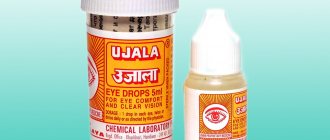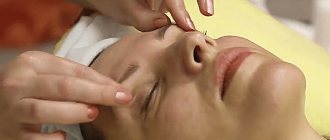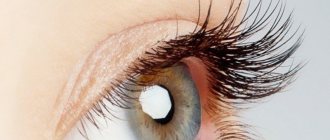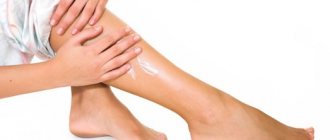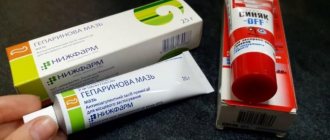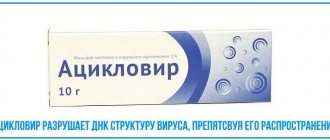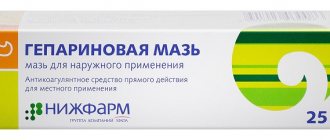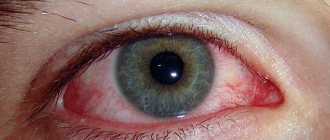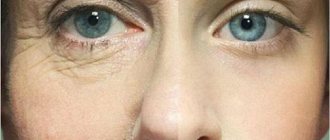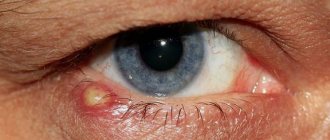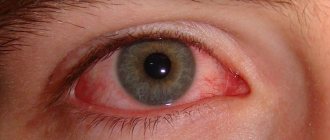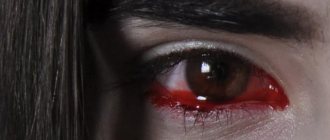Composition and mechanism of action for eye diseases
Eye gel 0.25% contains 2.5 mg of active substance per gram. Composition of Oxolinic ointment:
- active substance – dioxotetrahydroxytetrahydronaphthalene;
- auxiliary components (liquid paraffin, petroleum jelly, citric acid).
The product is used in adults and children for ophthalmological problems. The action of Oxolinic ointment is to block the cell membrane, which prevents the penetration of viruses.
The instructions for use included in the Oxolin package contain the following information about the therapeutic effects of the ointment:
- eliminates burning and itching of the eyes;
- removes symptoms of inflammation, redness of the sclera;
- reduces excessive lacrimation;
- relieves pain.
After being placed in the lower eyelid, 20% of the substance enters the eye. The peculiarity of the drug is that it does not penetrate into the blood. Because of this, the gel does not have a toxic effect on the body.
Composition and release form
The drug is produced in aluminum tubes with an internal coating, with a nominal value of ten grams.
Ointment of dense consistency, with a white tint.
The active substance of oxolinic ointment is dioxotetrahydroxytetrahydronaphthalene, this is tetraoxaline, the main name of the ointment comes from this component.
Also, oxolinic ointment consists of:
- Citric acid.
- Liquid paraffin.
- Vaseline.
Oxolinic ointment is available in tubes of 10 g
Indications and contraindications for using eye ointment
The drug is prescribed by doctors and used by the population during an outbreak of seasonal viral infections to prevent influenza. Lubricating the nasal cavity prevents the spread of the virus to the organs of vision.
In addition to alleviating the symptoms of eye diseases, Oxolinic ointment has the following indications for use:
- flu;
- adenovirus;
- conjunctivitis;
- barley;
- blepharitis;
- keratitis;
- inflammation of the eyelids
For conjunctivitis, Oxolinic ointment is used in some cases at the discretion of the doctor. Bacterial inflammation of the mucous membranes of the eyes requires the use of antibiotics. Oxolinic eye ointment will complement complex therapy.
Contraindications for Oxolinic ointment in most cases are limited to individual intolerance to the active substance or constituent ingredients. In case of an acute allergic reaction, rinse your eyes with warm water and consult an ophthalmologist.
Oxolinic eye ointment instructions for use
Oxolinic ointment is a synthetic drug, the active component is oxolinum, has an antiviral effect, is effective against herpes, adenoviruses, and influenza.
The components of oxolinic ointment enter the tissues at the moment of contact with the active substance, destroying viruses.
Several different types of ointment are produced, the difference between them is in the percentage of the active component.
For use on the mucous membranes of the eye, use only 0.25% ointment.
It is better to store the ointment at a temperature no higher than ten degrees in the refrigerator.
Do not give to children.
Directions for use and dosage for eyes
In many ways, the result of treatment depends on the patient’s compliance with general hygiene. The product cannot be rubbed in, because it will distribute itself throughout the mucous membranes of the eye.
It is recommended to perform the following sequence of drug administration into the lower eyelid:
- Immediately before use, wash the eyes with boiled water.
- Discharge from the inner corners is removed with a cotton pad soaked in chamomile decoction.
- By retracting the lower eyelid, 0.2 g of the drug is injected into the conjunctival sac, which is equivalent to 1 cm of squeezed tape.
- After application, it is recommended to close your eyes and not blink for 1 minute.
For adenovirus or influenza, the ointment is applied 5 times during the day. For patients with viral diseases, frequent use will help eliminate symptoms of irritation. The duration of treatment is determined by the ophthalmologist depending on the overall clinical picture. Usually standard therapy lasts 5 days, but sometimes the course is extended by the doctor to 1 month.
An old, proven and effective remedy. Oxolinic ointment - what does it help with?
What does oxolinic ointment help with?
The main use is in the treatment and prevention of influenza.
In addition to treating a runny nose, oxolinic ointment helps with the following conditions:
• rhinitis of viral etiology, sores of the nasal cavity after a runny nose, acute respiratory infections, ARVI, chickenpox;
• in dermatology: lichen vulgaris, herpes zoster and blisters, psoriasis, herpes, candilomas, warts, spinules, dermatitis caused by herpes, molluscum contagiosum;
• in ophthalmology for inflammation of the eyeball, damage to the mucous membrane of the eyes with herpes, keratitis, conjunctivitis.
Important. Due to the absence of accumulation of the drug and systemic effect on the body, oxolinic ointment allows you to treat diseases that require the long-term influence of an antiviral drug without harm to health.
Before starting treatment, it is important to consult with a specialist, because with a bacterial infection there may be similar symptoms, but the ointment has no effect.
Prevention of flu and colds
Oxaline ointment helps in the early stages of acute respiratory infections, and is also effective as a preventive agent during quarantine for a viral infection.
How to use:
• using a cotton swab, apply a thin layer of ointment along the inner surface of the nose 1-2 times a day for prevention and 3-4 times if infection has already occurred;
• before applying a new portion of the drug, be sure to rinse the nasal cavity with saline solution (you can dilute ½ teaspoon in a mug of water at room temperature yourself or take a ready-made isotonic solution);
• if there is a high risk of infection, you can enhance protection by applying oxolinic ointment to the oral cavity. It is used more often in young children. For young children, you can lubricate the pacifier or apply it to the root of the tongue using a cotton swab.
In case of symptoms of sore throat, it is allowed to use ointment after gargling with antiseptic drugs or decoctions of anti-inflammatory herbs.
Oxolinic ointment for eye inflammation
For keratoconjunctivitis caused by a viral infection (usually adenovirus), 0.25% oxolinic ointment helps well. A course of treatment of 5-7 days consists of applying the product over the centuries up to 3 times a day.
It is important to remember that in case of eye inflammation caused by a bacterial infection, the effectiveness of oxolin is zero; the drug is prescribed only when a viral infection is specified. With a bacterial infection, purulent discharge is pronounced; with a viral infection, itching and burning of the eyes comes to the fore with minor discharge from the affected eye without any admixture of pus.
Oxolinic ointment helps with viral stomatitis
For the treatment of stomatitis of viral origin, the drug 0.25% is used. Each ulcer is carefully coated with ointment and a thin layer is applied to the entire oral cavity in order to prevent the formation of new aphthae.
Important. Before each application of the ointment, the oral cavity must be thoroughly cleaned:
• brushing teeth during stomatitis should be gentle, without excessive mechanical impact on the affected gums.
• Remove the resulting crusts using a cotton swab soaked in sterile oil. You cannot pick or pick out ulcers;
• Rinse your mouth with a decoction of chamomile, sage or a ready-made pharmaceutical antiseptic (furacilin, chlorhexidine).
• Lubricate the oral cavity with oxolin, paying special attention to ulcers. The course of treatment depends on the course of the disease and is carried out until the oral mucosa is completely healed. Important. When applying the drug, movements should be light and wet. Rubbing the product is not allowed.
• Solcoseryl is used at night.
Oxolinic ointment helps with warts
Treatment of warts with oxolinic ointment takes from 3 to 7 months. A 3% ointment solution is applied to the affected area.
Method of treatment
• Rinse the skin and wart thoroughly and dry with a towel;
• Apply ointment directly to the wart and the skin around it in a thin but dense layer;
• place a sterile gauze pad on top;
• place wax paper or polyethylene on a napkin;
• bandage well.
The procedure is carried out at least 2 times a day until the problem is completely eliminated.
Oxolinic ointment helps with herpes
The herpes virus affects 80% of the population. When the disease worsens, itching, burning, and pain are felt in the area of the rash; blisters appear, which subsequently burst, forming ulcers.
Therapy for herpetic rash is carried out with 3% ointment. Apply directly to the affected area 3-4 times a day. For mild forms of pathology, the course does not exceed 2 weeks. In case of a complicated course of the disease, oxolinic ointment is applied until the wounds are completely healed. If necessary, oral antiviral drugs are added.
Does oxolinic ointment help with chickenpox and lichen?
Treatment of chickenpox with oxolinic ointment is not welcomed by every pediatrician.
To treat chickenpox, 3% ointment should be used to treat skin rashes; if blisters and ulcers are localized on the mucous membrane, 0.25% ointment should be used.
Apply a thin layer 2-3 times a day to each element. The course of therapy is up to a week.
Oxolinic ointment prevents the spread of infection throughout the body and accelerates the healing of inflammatory elements.
When a diagnosis is made: herpes zoster or lichen simplex, the instructions for use correspond to the described actions for chickenpox.
Molluscum contagiosum and oxolin
Damage to the skin by the smallpox virus - molluscum contagiosum - is treated with oxolinic ointment. For treatment, 3% or 0.25% of the drug is used, depending on the location of the damaging element. If the mucous membrane is damaged, a less concentrated drug is used. The course of application is from 2 - 6 weeks to six months.
Contraindications for use
Treatment of pregnant and nursing mothers is possible only after consultation with a doctor; studies of the effect of oxolinic ointment during lactation have not been conducted.
In case of an allergic reaction to the components of the ointment, treatment with the drug is not permissible.
In addition, the development of adverse reactions may prohibit treatment with the drug:
• feeling of burning and irritation when applying the product;
• profuse nasal discharge (rhinorrhea) after applying the ointment;
• skin irritation - contact dermatitis.
If minor reactions to treatment develop, the question of further use should be considered by a doctor; in case of serious complications, the drug should be discontinued.
Analogs
There are no preparations containing oxolin, however, many antiviral agents in external and tablet forms have similar properties.
Preparations for external use:
• Acyclovir gel and ointment form;
• Vartek;
• Zovirax;
• Fenistil
• Lomargepan.
For a systemic effect on the virus, tablets and capsules are used:
• Arbidol;
• Amiksin;
• Kagocel;
• Lavomax;
• Ergoferon.
Be careful and always consult your doctor
zhenskoe-mnenie.ru
Use in special patient groups
Oxolinic ointment is prescribed to children and women during the pre- and postpartum period according to a doctor’s prescription and is used strictly according to the instructions. Precautionary measures will eliminate unwanted consequences of use in the form of allergies.
Children
The annotation attached to the package clearly indicates at what age the drug can be used. It is prescribed to children after two years of age. For infants, oxolinic ointment is used only in special cases and under the supervision of a doctor.
Pregnant and nursing
The instructions for use warn that pregnant women may develop complications due to taking the ointment. Therefore, during pregnancy, the drug should not be used unnecessarily. The same applies to women who are breastfeeding.
Side effects
Side effects after applying Oxolinic ointment to the eyes are rarely observed. The following are signs of intolerance:
- temporary visual impairment;
- runny nasal discharge;
- scleral hyperemia;
- skin rash.
If such symptoms occur, you should rinse your eyes under running warm water. If the redness does not go away within 1-2 days, you can instill Allergodil and consult a doctor as soon as possible.
Analogs
When the season of treatment or prevention of influenza comes, the question arises of what to replace oxolinic ointment with. Now many doubt its effectiveness, saying that it has not been proven. This is partly true because clinical trials of the drug have not been conducted.
The cost of Oxolinic ointment itself 0.25% with a capacity of 10 grams ranges from 25 to 45 rubles. There is no product that is completely identical in composition. But there are many analogues in pharmacies.
Let's consider the most popular agents with antiviral activity:
- Zovirax . This eye ointment contains the active ingredient acyclovir. When applied topically, it inhibits viral DNA synthesis without damaging healthy tissue. It enters the bloodstream in small quantities and is excreted in the urine. Manufactured by Glaxo Wellcome, and the average price in the pharmacy chain is 480 rubles.
- Zirgan gel . The antiviral ophthalmic drug was developed by the Japanese company Santen. The active substance ganciclovir is integrated into the DNA molecule of the virus, inhibiting its production. When applied topically, it kills herpes simplex, shingles, Epstein-Barr and chickenpox viruses. Packaging costs 640 rubles.
- Tebrofen ointment . Has a virucidal effect. Prescribed subconjunctivally for epidemic adenovirus, keratitis, conjunctivitis of viral origin. Produced in Russia. A package of 10 or 30 ml can be purchased for 30–70 rubles.
- Virolex . Eye ointment 3% is active against many strains of viruses. The drug is based on acyclovir with the addition of petroleum jelly. The active substance of Virolex destroys the basis of the virus - DNA, leading to cell death. The drug is prescribed for herpetic keratitis and conjunctivitis. The treatment course lasts 7–10 days. Manufactured by KRKA, and the cost of packaging is 180 rubles.
Despite the many foreign antiviral agents, domestic Oxolinic ointment is in great demand. It is the ability to quickly relieve irritation of the eyes and nasal passages during the flu that helps the drug remain so popular.
Author: Lyudmila Plekhanova, doctor, especially for Okulist.pro
